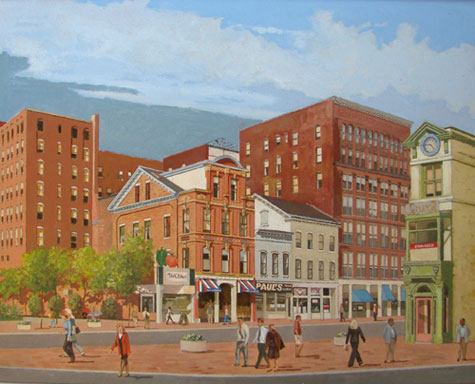A Robert Solotaire retrospective at Gleason
By KEN GREENLEAF | October 7, 2009
 SEEING THE DEMOS “Haymarket Congress Square,” by Robert Solotaire. |
The late Bob Solotaire collected views the same way he collected friends, and he had a great many of both. He was widely respected in the art community here in Maine and elsewhere, but career success always seemed to elude him. Artistic success did not, and this Gleason show of a fairly broad selection of his work shows why. The essential qualities of his work are subtle and, I think, often overlooked by causal observers and collectors.
Solotaire was a fully committed landscape painter, and did his share of views of the coast and country roads, but his native habitat was the city. He grew up in New York during the glory days of Broadway, in a family that moved easily among both stars of the theater and Times Square grifters. For him the city was a living organism that breathed through the lives of its denizens.
For me the way to approach Solotaire’s work, and to get a clear look at what makes it special, is to a start with an expressive study like “Weirton Remembered,” a view of large factory, probably a steel mill, with houses in the foreground. Not as highly finished as Solotaire’s more formal pictures, it shows his skilled hand and striking eye for color relationships.
Next go to “138th Street Bridge,” a view upwards at a complicated intersection of steel struts, beams and flanges riveted together the way steel structures were built before World War II. His angle of view makes for a dynamic abstract design, with diagonal lines coming in from the edges and meeting together. Then go to the smaller “Commercial Street Yellow Fire Hydrant” for a sense of Solotaire’s gentle touch and quiet humor.
These threads come together in his views of the city like “Haymarket Congress Square.” Here are the dynamics of multiple-point perspective, the many reds of the bricks, greens from the building on the right echoed by the trees in the little park on the left, and, unlike many of the paintings, there are people walking and standing. They aren’t actors in some urban drama, just people on their way somewhere as part of the substance of their lives.
There is an implied presence of people in all his work. More than anything else, Solotaire had a poetic humanism that was the foundation of everything he did. In “Weirton Remembered” the houses overshadowed by the factory feel occupied. There’s no social statement here about the abuses of industrial capitalism, but instead something more profound — the sense that people here are, for better or worse, carrying on the best way they can. You can see it in the little American flag in the corner. It says “here we are.”
Solotaire saw that everywhere. The carefully rendered rivets in “138th Street Bridge” are a record of days of hard work. The tire tracks and little stairs in “Topsham Asphalt” remind us that people work here. The cat in the window in the building above “Bedford Industrial Products” adds a grace note to the hardware store below. People come here daily for what they need, and some of them live in the neighborhood.
Solotaire finds beauty in the city and in the industrial landscape, and indeed there is much of formal visual interest in the factories, cranes, signs, and bridges. But there is more. Someone drives the trucks, puts up the flag, lights the fires, and paves the roads. These things go on all the time, shut away from our conscious notice. We avoid the dust and heat of the asphalt plant but are grateful for smooth roads.
This understated presence of humanity in its broadest sense sets Solotaire’s work apart from other painters. Like all true artists (of which there are very few), he gently gave us the opportunity to see ordinary things in a new and deeper way.
Ken Greenleaf can be reached atken.greenleaf@gmail.com.
"ROBERT SOLOTAIRE (1930-2008): PAINTINGS" | through November 14 | at Gleason Fine Art, 545 Congress St, Portland | 207.699.5599
 Related
Related:
Summer people, Retro for fall, Left out, More 
- Summer people
Ever wonder why there is so much professional-level art made and shown in Maine, a state with a total population less than that of many minor cities? One answer is that following the fame of people like Winslow Homer, creative types flocked to Maine, often to artists' colonies.
- Retro for fall
Leaves are turning, roads aren't crowded; it's time to look ahead for interest in the fall art season.
- Left out
I first heard about Stanley five years ago, from a firefighter up on Munjoy Hill.
- Enrich thy neighbor, Portland
Back in the temperate zone, the local and national economies are in the crapper.
- One city, many angles
Artists capture the city for Greenhut's fourth biennial Portland Show
- Democracy in China
That December morning in the year 2010 began oddly. The sun rose in the west. The river reversed itself and flowed upstream. The tide went out and didn't come back.
- What's wrong with Augusta?
Charlie Colgan couldn't predict a recession if its arrival was signaled by warning lights and sirens.
- Olive Café
Solid tastes at Olive Café
- Interview: Greil Marcus
Greil Marcus on rock-and-roll photography
- The electric company
We all know how in 1965, at the Newport Folk Festival, the previously all-acoustic Bob Dylan took the stage with an electric guitar, plugged in, enraged fans, and destroyed the folk-music scene forever.
- Is black the new black?
Was new Portland police chief picked because he is black?
- Less

 Topics
Topics:
Museum And Gallery
, Robert Solotaire, Gleason Fine Art, Gleason Fine Art